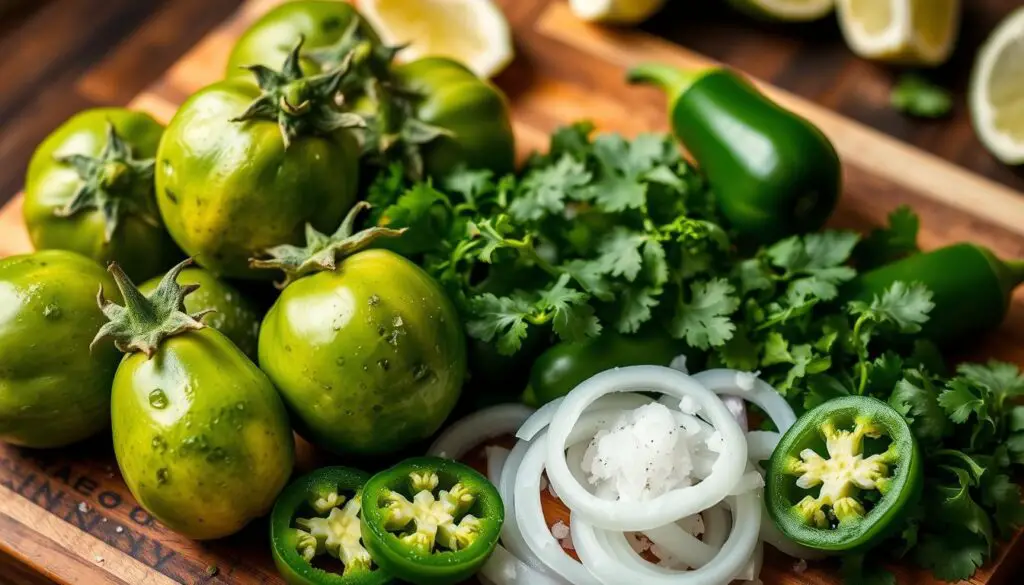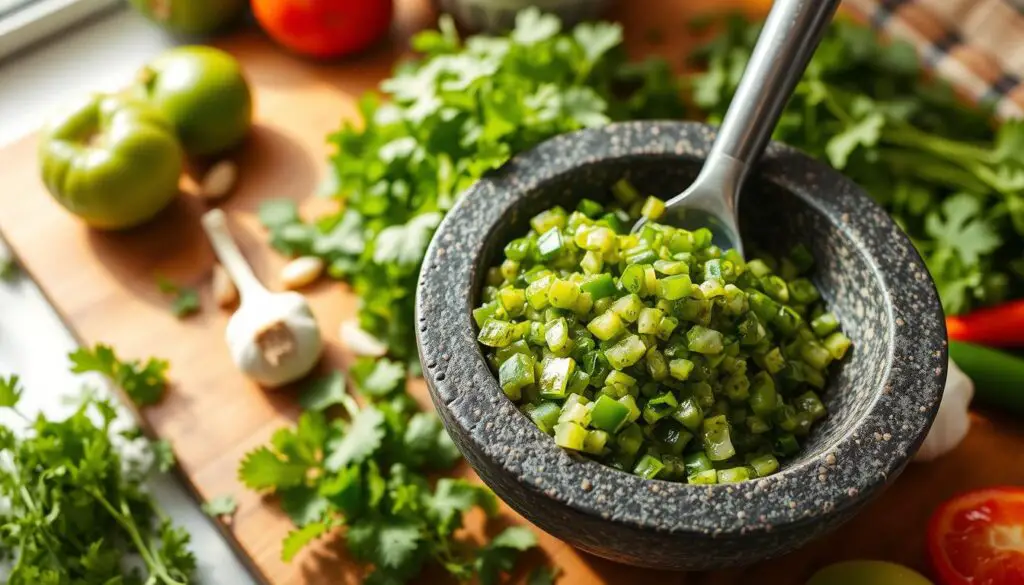In the world of Mexican cuisine, Pico de Gallo and Salsa Verde are two favorites. They may look similar, but they have different ingredients and ways of making them. Knowing the differences between these two can make you appreciate Mexican food more. It also helps you pick the right dip for your meals.

Introduction
Traditional Mexican sauces, or “salsas,” have a long history. They come from the Aztec, Incan, and Mayan civilizations of Mesoamerica. These vibrant condiments have changed over time, showing the mix of cultures that shaped Mexican food.
Overview of Pico de Gallo and Salsa Verde
Pico de Gallo and Salsa Verde are two famous Mexican sauces. Pico de Gallo looks like the Mexican flag and is named after a rooster’s beak. Salsa Verde is bright green and tangy, made with tomatillos.
Both sauces have deep roots in Mesoamerica. The Aztecs first grew tomatoes, a key ingredient in their sauces. The word “salsa” was introduced by Alonso de Molina in 1571, after the Spanish invasion.
The development of these sauces was influenced by indigenous traditions and Spanish colonization. They have become a big part of Mexico’s culinary history. Today, they are loved in many homes around the world.
Definition of Pico de Gallo
Pico de Gallo is a fresh, chunky salsa made from uncooked, finely diced ingredients. It mainly includes diced tomatoes, onions, jalapeños, cilantro, and lime juice. These ingredients are chopped into small pieces and mixed together. This creates a vibrant, fresh-tasting condiment with a distinct chunky texture and flavor.
Ingredients and Preparation Method
To make Pico de Gallo, you need:
- 4 large Roma tomatoes (about 1 lb), diced
- 1 medium jalapeño, finely diced
- 1/2 cup finely diced white onion
- 1 teaspoon minced garlic
- 1/4 cup chopped cilantro
- 1 lime, juiced
- 1/8 teaspoon salt
Just chop and mix the ingredients. This makes a fresh, chunky salsa. It’s great as a topping or side for Mexican dishes like tacos and burritos.
“Pico de Gallo is a vibrant, fresh-tasting condiment that showcases the natural flavors of its uncooked ingredients.”
pico de gallo vs salsa verde
Pico de gallo and salsa verde come from Mexico but are different in ingredients and taste. They are both salsas but have unique flavors. Knowing the differences can make your cooking better.
Pico de Gallo is a fresh, chunky salsa. It’s made with tomatoes, onions, jalapeños, cilantro, lime juice, and salt. It’s always raw, keeping its bright, fresh taste.
Salsa Verde is cooked and made with tomatillos, garlic, onions, chili peppers, and herbs. Tomatillos give it a tangy, sweet flavor. This makes salsa verde different from salsa roja.
| Pico de Gallo | Salsa Verde |
|---|---|
| Uncooked, chunky texture | Cooked, smoother texture |
| Tomato-based | Tomatillo-based |
| Bright, fresh flavors | Tangy, slightly sweet |
| Shorter shelf life (up to 3 days) | Longer shelf life (5-7 days) |
Both pico de gallo and salsa verde are great for many dishes. Knowing their differences helps you pick the best one for your recipes.
Definition of Salsa Verde
Salsa Verde is a vibrant green sauce. It gets its unique taste from tomatillos, not red tomatoes. Tomatillos give it an acidic and earthy flavor, unlike tomato-based salsas.
Unlike Pico de Gallo, Salsa Verde can be cooked or raw. The cooked version is smoky and robust. The raw version is tangier and more sour. This lets cooks tailor the flavor to their liking.
“Salsa is one of the most popular condiments in the US, and Salsa Verde, with its tomatillo base, offers a distinct and delicious alternative to the classic tomato-based salsas.”
The flavor profile of Salsa Verde is bright, tangy, and earthy. Tomatillos add a complex savory taste. It’s great as a dip, topping, or side to Mexican and Tex-Mex dishes.

Ingredients and Preparation of Salsa Verde
The main ingredient in Salsa Verde is tomatillos, small, green fruits like tomatoes. It also includes garlic, onions, chiles, and fresh herbs like cilantro. You can use these ingredients raw or cooked, which adds a smoky flavor.
Using Tomatillos as the Base
Tomatillos are the heart of Salsa Verde, giving it a tangy, sweet taste. They are often confused with green tomatoes but are actually nightshade family members. Roasting tomatillos, chili peppers, and garlic adds a smoky flavor.
A typical recipe uses 1 1/2 pounds of tomatillos, 1 to 2 Serrano or jalapeño peppers, 4 garlic cloves, half an onion, and fresh cilantro. You also need salt to taste. After blending, the salsa has a smooth texture, unlike chunky Pico de Gallo.
| Ingredient | Amount |
|---|---|
| Tomatillos | 1 1/2 pounds (about 12 medium) |
| Serrano or Jalapeño Peppers | 1 to 2 |
| Garlic Cloves | 4 |
| Onion | 1/2 |
| Cilantro Leaves | 1/4 cup packed |
| Salt | 1/2 to 1 teaspoon |
Cooking Techniques for Salsa Verde
Making a delicious salsa verde needs careful preparation. The secret to its bright taste is in how you cook the main ingredient – tomatillos.
Roasting tomatillos is a favorite method. It heats them up so the outer husks burn and the inside gets soft and sweeter. This makes the salsa taste richer, with a hint of smokiness that goes well with the tomatillos’ tanginess.
- Roasting tomatillos at 400°F for 15-20 minutes brings out their natural sweetness.
- Charring the tomatillos directly over an open flame can also lend a delightful smoky complexity to the salsa.
Boiling tomatillos is another way to go. It makes them softer, so they blend well into a smooth salsa. Boiling also keeps the tomatillos’ bright green color, making the salsa look as good as it tastes.
“The cooking method you choose for the tomatillos ultimately affects the final flavor and texture of the salsa verde.”
Charring tomatillos is a good mix of smoky and fresh flavors. It gives them a nice char on the outside while keeping them juicy inside.

No matter the cooking method, the goal is to bring out the tomatillos’ natural flavors. By using different heat methods, you can create a delicious homemade salsa verde.
Texture and Consistency Differences
Pico de Gallo and Salsa Verde differ mainly in texture and consistency. Pico de Gallo is chunky, with each ingredient finely diced. This keeps the flavors of tomatoes, onions, cilantro, and more distinct, making it vibrant and textured.
Salsa Verde, on the other hand, is blended or pureed. This makes it smooth and uniform. Its blended nature melds flavors together, creating a cohesive taste. Its smoothness also makes it versatile for dipping or drizzling over dishes.
Chunky vs. Smooth Textures
Choosing between Pico de Gallo and Salsa Verde depends on personal taste and use. Pico de Gallo’s chunky texture is great for adding freshness to tacos, nachos, or grilled meats. Salsa Verde’s smooth, creamy texture is perfect for enchiladas, eggs, or as a dip for tortilla chips.
The choice between Pico de Gallo and Salsa Verde depends on flavor, texture, and use. Both offer unique and delicious experiences, catering to various tastes and culinary needs.
Flavor Profiles
Pico de gallo and salsa verde have different flavor profiles. Pico de gallo is known for its bright, fresh taste. This comes from the lime juice and the raw ingredients. Salsa verde, on the other hand, has a complex, smoky, and robust taste. This is because the tomatillos and other vegetables are cooked.
The bright and fresh taste of pico de gallo is great on tacos and grilled meats. The smoky and robust salsa verde is versatile. It can be used as a sauce, marinade, or dip to add depth to dishes.
Flavor Profiles at a Glance
| Pico de Gallo | Salsa Verde |
|---|---|
| Bright and Fresh | Smoky and Robust |
| Acidity from lime juice | Tomatillos lend a tangy, slightly tart flavor |
| Crispness of raw ingredients | Deeper, more intense flavor from cooked vegetables |
Whether you like the vibrant and zesty pico de gallo or the complex and savory salsa verde, both are great. They add a unique and delightful flavor to your Mexican-inspired meals.
Culinary Uses
Pico de gallo and salsa verde are great for adding flavor to Mexican dishes. Pico de gallo is perfect for topping tacos, burritos, and enchiladas. It adds a fresh crunch to these favorites. It’s also great as a dip for tortilla chips.
Salsa verde is great as a sauce or marinade for chicken, fish, or pork. It brings a rich flavor to these proteins. It’s also tasty on eggs or breakfast hash, adding a tangy twist.
Both pico de gallo and salsa verde are must-haves for Mexican cooking. They bring unique flavors and can be used in many ways. They’re key to making delicious, authentic Mexican dishes.
| Culinary Uses of Pico de Gallo | Culinary Uses of Salsa Verde |
|---|---|
|
|
Storage and Shelf Life
When it comes to pico de gallo and salsa verde, their storage and shelf life differ. Pico de gallo, being fresh and uncooked, has a shorter shelf life than salsa verde.
Pico de gallo should be eaten within 3-7 days when kept in the fridge. Its high moisture and lack of cooking can cause it to spoil faster. Keeping it refrigerated is key to keeping it fresh.
Salsa verde, on the other hand, can last 5-7 days in the fridge. Cooking the ingredients helps preserve them, making it last longer. Tomatillos in salsa verde also help it keep better.
| Salsa Type | Shelf Life (Refrigerated) |
|---|---|
| Pico de Gallo | 3-7 days |
| Salsa Verde | 5-7 days |
The exact shelf life can vary based on ingredients, how it’s made, and storage. Always follow food safety tips to keep it fresh and prevent spoilage.
The different shelf lives affect how you use these salsas. Pico de gallo is great as a fresh topping. Salsa verde is versatile for cooked dishes like sauces and marinades.
Conclusion
Pico de Gallo and Salsa Verde may look similar, but they are unique in Mexican cuisine. Pico de Gallo is a fresh, chunky salsa with raw ingredients. On the other hand, Salsa Verde can be cooked or raw, with tomatillos as its base. These differences make each condiment special and perfect for different dishes.
Knowing the differences between Pico de Gallo and Salsa Verde helps you appreciate Mexican food more. Whether you like the fresh taste of Pico de Gallo or the smoky flavor of Salsa Verde, they both add something special to Mexican dishes.
Choosing between Pico de Gallo and Salsa Verde depends on what you’re making. By understanding their differences and similarities, you can find new ways to enjoy Mexican food. This lets you explore the rich flavors of Mexican cuisine.
FAQ
What are the key differences between Pico de Gallo and Salsa Verde?
Pico de Gallo is a fresh, chunky salsa. It’s made with uncooked, finely diced tomatoes, onions, jalapeños, cilantro, and lime juice. Salsa Verde, on the other hand, uses tomatillos as its main ingredient. It also includes garlic, onions, chiles, and herbs.
Pico de Gallo tastes bright and fresh. Salsa Verde has a smoky, robust flavor.
How are Pico de Gallo and Salsa Verde prepared differently?
Pico de Gallo is made by chopping ingredients into small pieces and mixing them. This results in a chunky texture. Salsa Verde, by contrast, is blended or pureed, making it smooth.
The cooking methods for Salsa Verde, like roasting or boiling tomatillos, add to its complex flavor.
What are the primary ingredients in Pico de Gallo and Salsa Verde?
Pico de Gallo includes diced tomatoes, onions, jalapeños, cilantro, and lime juice. Salsa Verde is based on tomatillos, small, green fruits related to tomatoes.
It also has garlic, onions, chiles, and herbs like cilantro.
How do the flavor profiles of Pico de Gallo and Salsa Verde differ?
Pico de Gallo is known for its bright, fresh taste. The lime juice and raw ingredients add to its crispness. Salsa Verde, on the other hand, has a more complex flavor.
This is due to the cooking of the tomatillos and other vegetables.
What are the typical culinary uses for Pico de Gallo and Salsa Verde?
Pico de Gallo is great as a topping for tacos, burritos, and enchiladas. It adds a fresh, crunchy element. Salsa Verde is often used as a sauce or marinade for chicken, fish, or pork.
It can also be used as a topping for dishes like eggs or breakfast hash.
How do the storage and shelf life differ between Pico de Gallo and Salsa Verde?
Pico de Gallo should be eaten within 3 days when stored in the fridge. It’s fresh and uncooked. Salsa Verde, being cooked, can last 5-7 days in the fridge.
The cooking process helps preserve the ingredients and extend its shelf life.
This site participates in the Amazon Services LLC Associates Program, an affiliate advertising program designed to provide a means for us to earn fees by linking to Amazon.com and affiliated sites. As an Amazon Associate, I earn from qualifying purchases at no extra cost to you.


